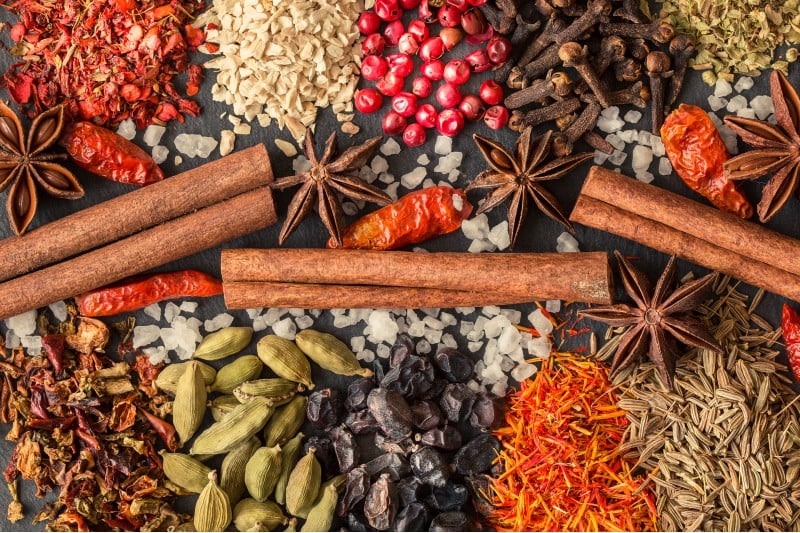Embark on a flavorful journey through the vibrant world of Indian spices with our beginner’s guide. From aromatic blends to fiery peppers, discover the key players in this ancient culinary tradition that will surely elevate your cooking to new heights. Whether you’re a novice in the kitchen or a seasoned pro, this article will provide you with the essential knowledge to navigate the complex and tantalizing world of Indian spices.

Introduction: Exploring the Vibrant World of Indian Spices
Embark on a journey to discover the rich and diverse world of Indian spices, where colors, flavors, and aromas come together to create a culinary experience like no other. From the fiery heat of red chili powder to the earthy warmth of cumin seeds, each spice tells a unique story and adds a layer of complexity to Indian dishes.
As you delve into the vibrant world of Indian spices, you will encounter a myriad of ingredients that play a crucial role in traditional Indian cooking. Whether you are a seasoned chef or a cooking novice, learning about these spices will open up a whole new world of flavor possibilities in your kitchen. Get ready to tantalize your taste buds and elevate your dishes to new heights!
From the bold flavors of garam masala to the tangy notes of amchoor (dried mango powder), Indian spices offer a sensory experience like no other. Each spice has its own distinct characteristics and culinary uses, making them essential components of Indian cuisine. As you explore this fascinating world, you will learn about the origins, flavor profiles, and health benefits of each spice, empowering you to experiment with different combinations and create your own signature dishes.
Understanding the Flavor Profiles of Common Indian Spices
Indian cuisine is renowned for its rich and diverse use of spices, each imparting unique flavors and aromas to dishes. is essential for mastering the art of Indian cooking. Here, we will explore some of the most widely used spices in Indian cuisine and delve into their distinctive characteristics.
Turmeric: Known for its vibrant yellow color, turmeric is a staple in Indian cooking. It has a warm, earthy flavor with a slight bitterness. Turmeric is often used in curries, rice dishes, and lentil soups.
Cumin: Cumin seeds are aromatic and have a nutty, peppery flavor. They are commonly used whole or ground in Indian spice blends and are crucial in dishes like dal and vegetable curries.
Coriander: Coriander seeds have a citrusy, <a%20title=”Thai Curry 101: A Simple Guide” href=”https://palatejourneys.com/2024/02/04/thai-curry-101-a-simple-guide/”>slightly sweet flavor with hints of earthiness. Ground coriander is a key ingredient in garam masala spice blends and is used in a variety of Indian dishes like chutneys, pickles, and marinades.
Key Tips for Storing and Using Indian Spices in Cooking
When it comes to cooking with Indian spices, proper storage and usage are key to enhancing the flavors of your dishes. Here are some essential tips to help you make the most out of your Indian spice collection:
- Store in a cool, dark place: To maintain the freshness and potency of your spices, store them in airtight containers away from heat, light, and moisture.
- Label your spices: It can be easy to mix up similar-looking spices, so make sure to label your containers to avoid any confusion while cooking.
- Toast whole spices: For maximum flavor, toast whole spices like cumin seeds, coriander seeds, and mustard seeds in a dry pan before grinding or using them in your dishes.
- Grind spices as needed: To preserve the flavors of ground spices, it’s best to grind them as needed rather than buying pre-ground spices.
| Spice | Best Pairing |
|---|---|
| Cumin | Curries |
| Turmeric | Rice dishes |
| Cardamom | Desserts |
| Coriander | Vegetable dishes |
Exploring Lesser-Known Indian Spices and How to Incorporate Them into Your Meals
Indian cuisine is known for its rich and complex flavors, thanks in part to the diverse range of spices used in traditional dishes. While many people are familiar with common spices like cumin, turmeric, and coriander, there are also a number of lesser-known Indian spices that can add a unique twist to your meals.
One such spice is amchoor, which is made from dried and powdered green mangoes. This tangy spice adds a citrusy flavor to dishes, making it a great addition to curries, chutneys, and marinades. Another lesser-known spice is asafoetida, a pungent powder made from the resin of a plant in the celery family. Asafoetida is often used in vegetarian dishes to add a savory, umami flavor.
If you’re looking to incorporate these lesser-known Indian spices into your cooking, try using them in simple dishes like lentil soups, <a%20title=”A Beginner’s Guide To Indian Spices” href=”https://palatejourneys.com/2023/05/10/a-beginners-guide-to-indian-spices/”>vegetable stir-fries, or even sprinkled on top of roasted nuts for a flavorful snack. Experimenting with new spices can help you broaden your culinary horizons and discover new favorite flavors.
As you embark on your journey into the world of Indian spices, remember that each spice tells a story of its own. From the fiery heat of red chili powder to the earthy richness of cumin seeds, these vibrant flavors have the power to transport you to bustling markets and bustling kitchens across India. So go ahead, experiment with different spices, and let your taste buds guide you on a culinary adventure like no other. And who knows, perhaps the next time you cook a meal, you’ll find yourself creating a masterpiece that pays homage to the rich heritage and diverse flavors of Indian cuisine. Happy cooking!








